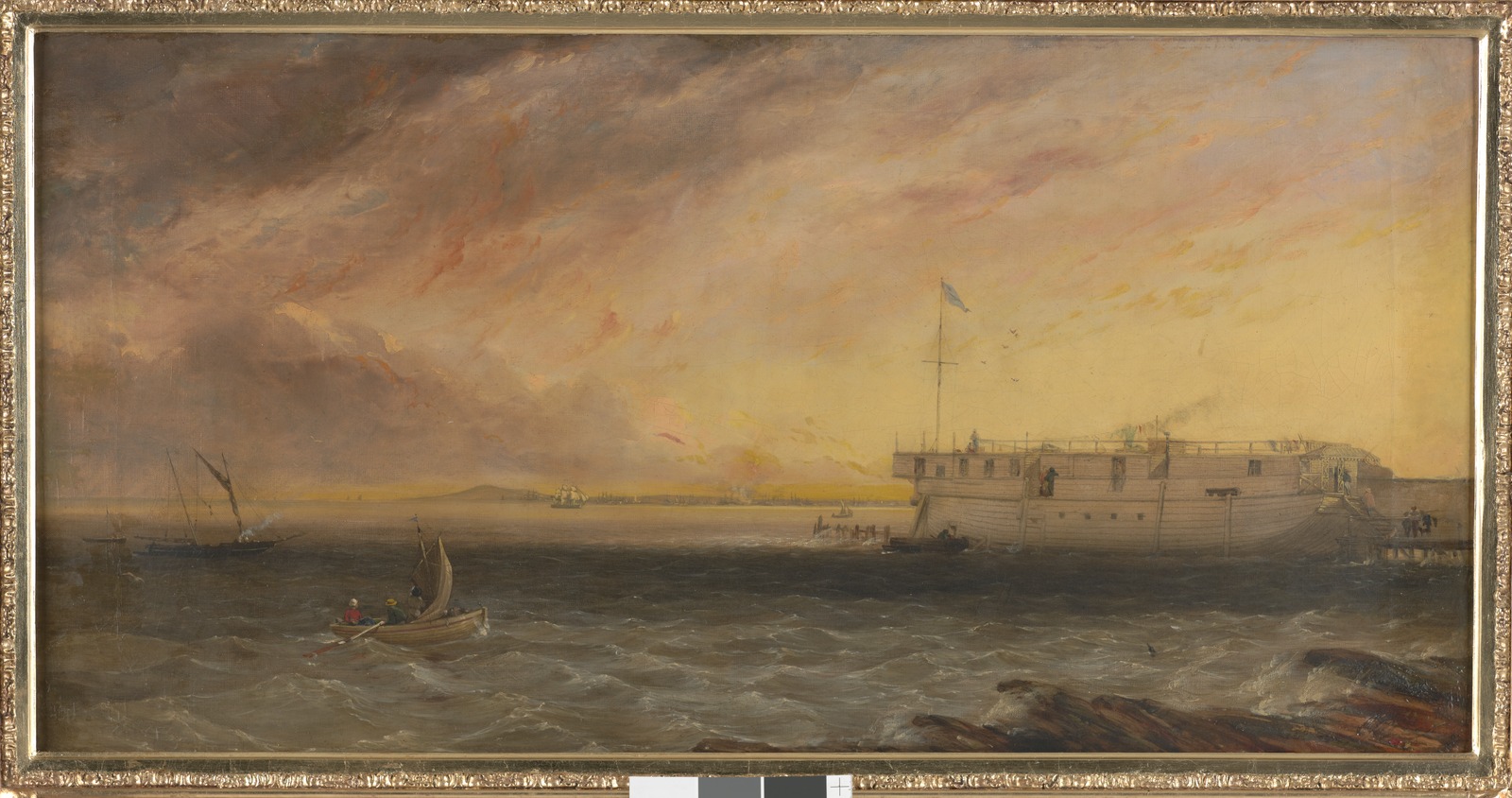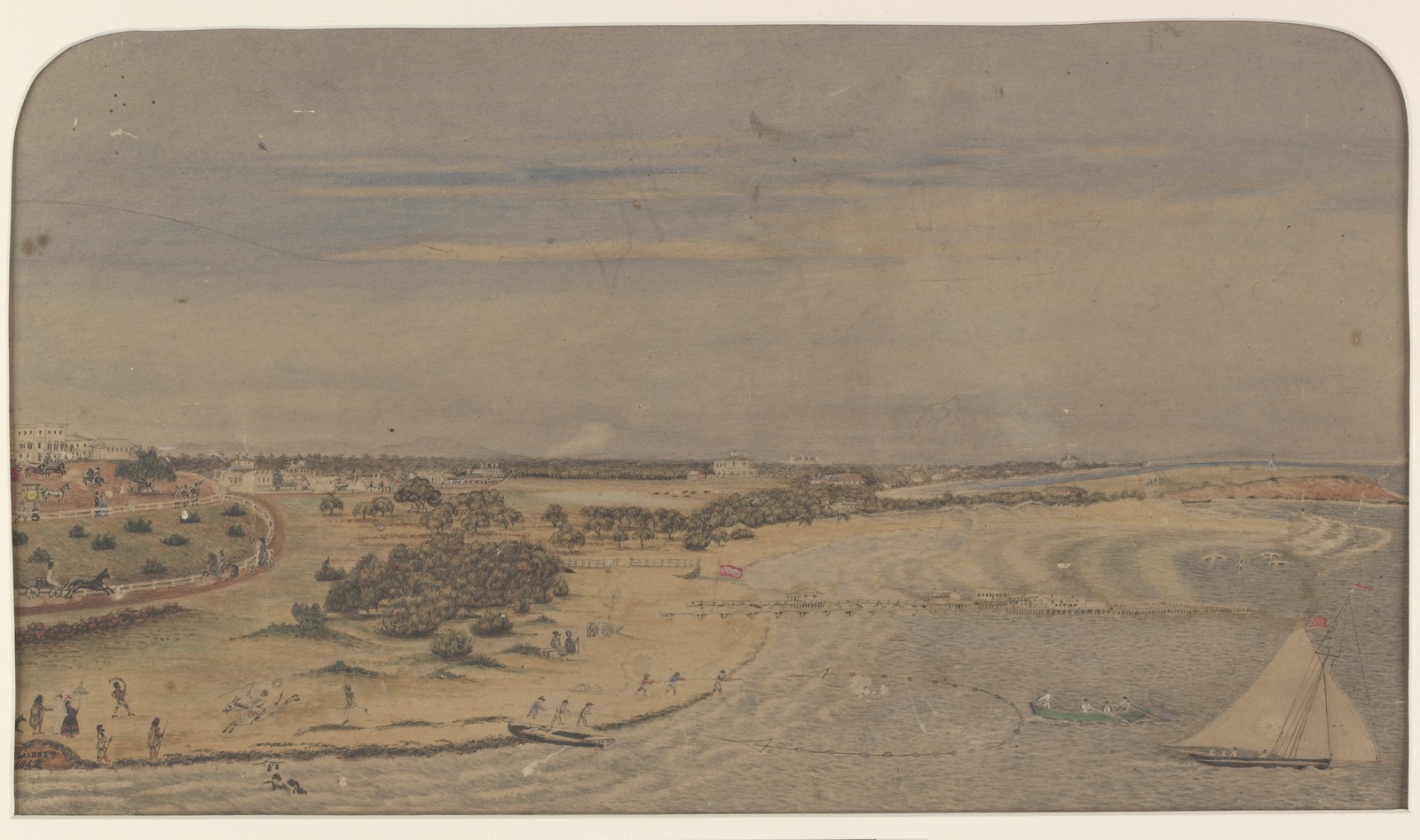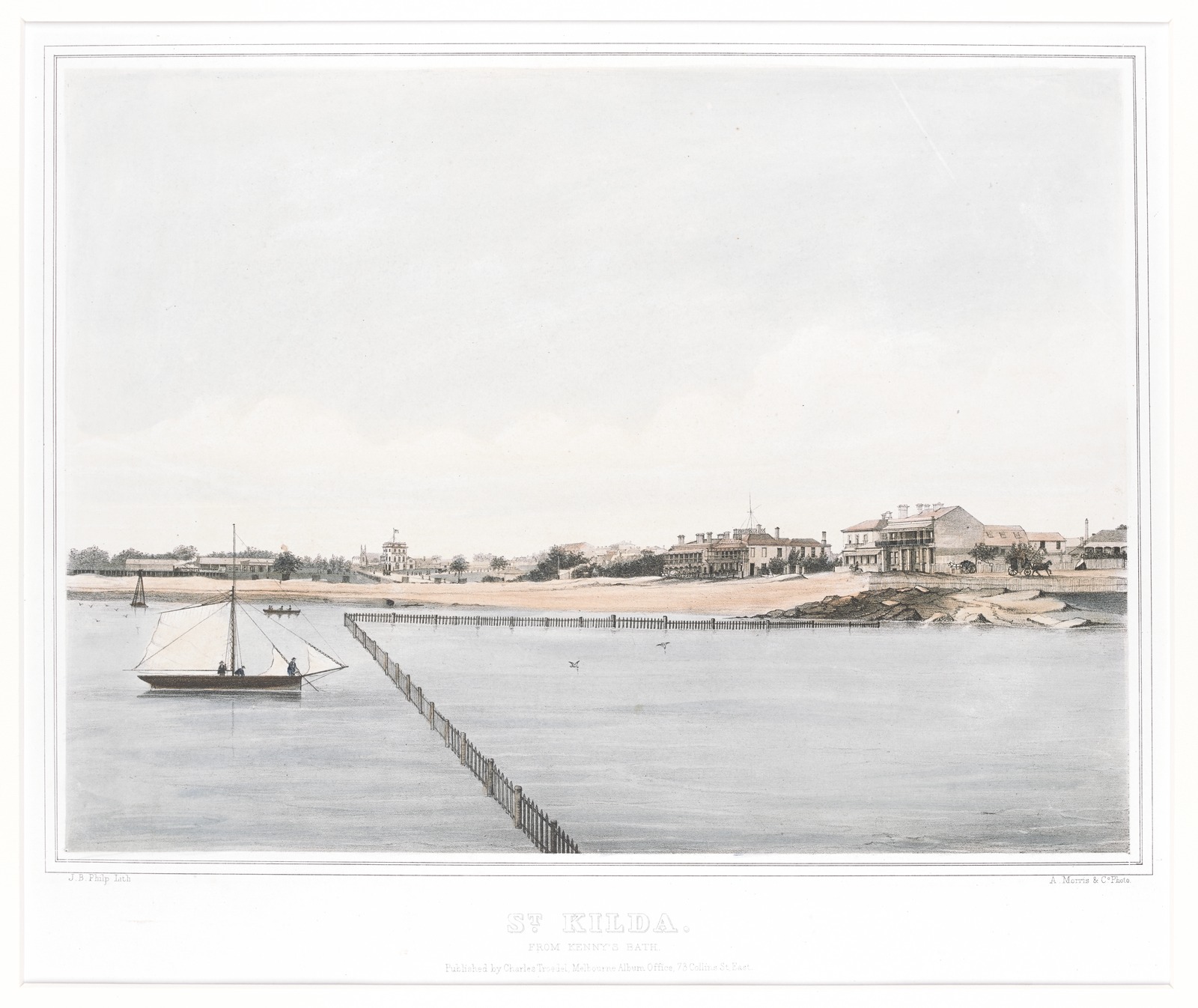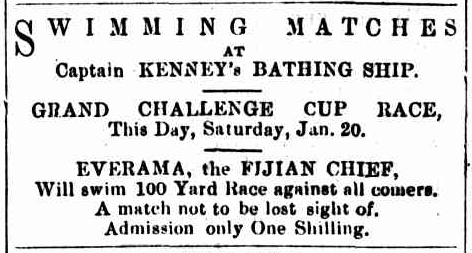 Kennedy’s (sic) bathing ship for gentlemen, St Kilda, Melbourne,1 [ca. 1869 – ca. 1871]. Drawing by Eliezer Levi Montefiore; H1839
Kennedy’s (sic) bathing ship for gentlemen, St Kilda, Melbourne,1 [ca. 1869 – ca. 1871]. Drawing by Eliezer Levi Montefiore; H1839
On 20 February, 1854, the Swedish brig, Nancy, arrived in Port Philip Bay. The Argus newspaper warned Victorians to look out for convicts, as she had come via the penal colony in Western Australia:
‘Look out. We perceive forty steerage passengers by the Nancy from Hong Kong, via Swan River. Are these men bond or free?’ (Argus, 21 February 1854)
In addition to her 42 passengers, Nancy’s cargo included: ‘30 bales of salt fish, 5 tombstones, 71 pine planks and a considerable quantity of brandy, sherry and champagne’.2
The goods were unloaded, and Nancy was abandoned in Hobsons Bay, along with scores of other ships whose crews had deserted to seek their fortunes on the goldfields.
Nancy was thought to be close to 150 years old. She had been built as a whaling ship by ‘experienced Norsemen’, designed to withstand the ‘crush of pack ice’.3 Despite these attributes, she was deemed unseaworthy and listed for sale.
 Kenney’s baths, St. Kilda, [ca. 1854]; H2009.165. This oil painting is unsigned but is attributed to Thomas Clark
Kenney’s baths, St. Kilda, [ca. 1854]; H2009.165. This oil painting is unsigned but is attributed to Thomas Clark
Retired sea captain William Kenney recognised Nancy’s potential immediately. The fact she was unseaworthy was of little consequence, as Kenney had a different purpose in mind: ‘My idea was to bathe inside the ship’, he wrote in 1898. ‘The ship was partly filled with sea sand which made an excellent bottom to the bathers …’4
Kenney purchased Nancy and went to work, dismantling the brig and selling off her fittings, although it’s said he couldn’t part with her bell. The ship was scuttled on the south side of St Kilda pier, where she was transformed into a gentlemen’s bathing ship.
Nancy was ballasted with sand to hold her steady, and her hold was filled with sea water for bathing. However, the ship was barely afloat before Kenney was told he would have to move her, as she was too close to the ladies’ bathing area. (In the 1850s, men bathed in the nude).
Nancy’s new location was on the north side of the St Kilda Pier, opposite Fitzroy Street. A narrow pier was built to connect her to the shore, and fences were erected to create ‘paddocks’ for bathers. The fences served a double purpose – protecting swimmers from roaming sharks whilst also acting as a privacy screen.
 Detail from St Kilda (map) 1900, showing location of Kenney’s bathing ship (top left) in 1900. You can see Kenney’s competitors beneath her
Detail from St Kilda (map) 1900, showing location of Kenney’s bathing ship (top left) in 1900. You can see Kenney’s competitors beneath her
 “St Kilda foreshore and Point Ormond, Red Bluff 1862/”. Watercolour by WFE Liardet; H13197
“St Kilda foreshore and Point Ormond, Red Bluff 1862/”. Watercolour by WFE Liardet; H13197
 St. Kilda. from Kenney’s bath, [1864]. Lithograph by James Buckingham Philp; H15466. A fenced off ‘paddock’ adjoining Captain Kenny’s bathing ship. You can see a view of St Kilda in the background
St. Kilda. from Kenney’s bath, [1864]. Lithograph by James Buckingham Philp; H15466. A fenced off ‘paddock’ adjoining Captain Kenny’s bathing ship. You can see a view of St Kilda in the background
Kenney’s bathing ship proved popular with the Victorian public, and was soon a favourite haunt for Melbourne’s elite. Barristers and Supreme Court judges, politicians and English swimming ‘stars’ – all enjoyed a dip at Captain Kenney’s sea baths (Age, 15 February 1930).
Nancy regularly hosted maritime swimming events and sea carnivals. Spectators would use the ship as a grandstand, with the events taking place in the ‘paddocks’ below. Program events were an eclectic mix. There were diving matches ‘for the recovery of objects from the bottom of the sea’, ‘walking the greasy pole’, and ‘swimming matches’ with ‘hands to be tied behind the back’.

 Argus, 15 February 1867, p 8
Argus, 15 February 1867, p 8
In 1856, members of the Victorian Yacht Club held their meetings in a cabin inside the Nancy’s bow – a copy of the club rules laid out on the table.5
Melbourne’s fickle weather was a perennial problem. In 1858, Melbourne was hit by a storm, and the fences surrounding Kenney’s bathing ship were destroyed.6 In 1862, Kenney’s resolve was again tested, this time in the form of a flood. The force of the floodwaters was so strong that Nancy was knocked over onto her side. Kenney, who was living on the ship, managed to safely remove his family to shore, but then he himself became stranded on the ship for three days.7
In 1863, another wild storm struck the city. Whilst Kenney’s bathing ship withstood the battering, its fences did not. They were found strewn, in pieces, along the beach sand. (Argus, 17 December 1863, p 5)
 The Esplanade, St Kilda Vic., [ca. 1870 – ca. 1880]; H2006.56/16. You can see a sign advertising Captain Kenney’s baths in the background
The Esplanade, St Kilda Vic., [ca. 1870 – ca. 1880]; H2006.56/16. You can see a sign advertising Captain Kenney’s baths in the background
The popularity of Captain Kenney’s bathing ship continued into the 1870s and ’80s. In 1873, patrons could purchase an all inclusive ticket covering their first-class return railway ticket and a bath for a cost of 1 shilling (Argus, 16 January 1872, p 8). ‘Night bathing a luxury by gas’ was also advertised (Age, 17 February 1873, p 1).
Captain Kenney obtained permission to construct stalls for his patron’s saddle horses on the foreshore. Alcohol was sold at the stalls, until he was fined for selling liquor without a licence (Herald, 27 February 1877, p 3).
 St. Kilda foreshore, Victoria, [between 1890 – 1910]. Photo by NJ Caire; H2014.184/125
St. Kilda foreshore, Victoria, [between 1890 – 1910]. Photo by NJ Caire; H2014.184/125
By the turn of the century, Nancy had fallen out of favour with the St Kilda council, many of whose members had financial interests in opposing sea baths. The public too, were tiring of her presence.
How long may I ask, sir, is that dilapidated old barge and ramshackle to be tolerated on the approach to the Esplanade – namely, Kenney’s bathing ship. The inclosure (sic) round this hideous pile of worm-eaten, weather-beaten hulk and lean-to, in years gone by served its purpose as a bathing ground, but it has long since lost its utility, owing to the constant silting-up process in the bay. It has served its purpose – move it on – send it further north, where it can get deeper water, and where its location will not blot out the view of the bay …
(Prahran Telegraph, 15 September 1906, p 5)
In 1906, the council offered to purchase all of Kenney’s bathing establishments for 5000 pounds (in addition to Nancy, he owned several others). Kenney refused to sell, and sadly, died soon after.
By 1910, the council’s view hardened, and it was determined that Kenney’s bathing ship had to go. Nancy was removed in 1912, and her second life as a bathing ship came to an end.
Captain Kenny’s Kenney’s bathing ship, St. Kilda, 1911. Photo by Lucy Archibold photographer; H7901. The remains of Captain Kenney’s bathing ship in 1911
Further reading
Bennnett, B, 2013, Sea baths of Victoria, Bruce Bennett, Hawthorn, Vic
Cooper, JB, 1931, The history of St Kilda: from its first settlement to a city, and after 1840 to 1930, vol 1, Printers Proprietary Ltd, Melbourne, Vic
References
- Kenney’s name was misspelt by the artist.
- Cooper, JB, 1931, The history of St Kilda: from its first settlement to a city, and after 1840 to 1930, vol 1, Printers Proprietary Ltd, Melbourne, Vic, p 159
- As above, p 160
- Letter by Kenney to Corporation in VPRS, 242/P0/29. Cited in Bennett, B, 2013, Sea baths of Victoria, Bruce Bennett, Hawthorn, Vic, p 23
- As above, p 170
- As above, p 163
- As above, p 163


